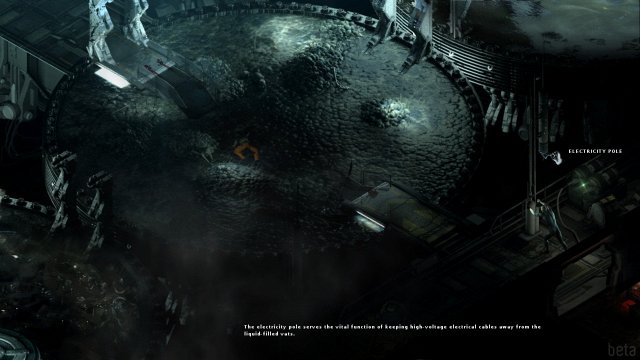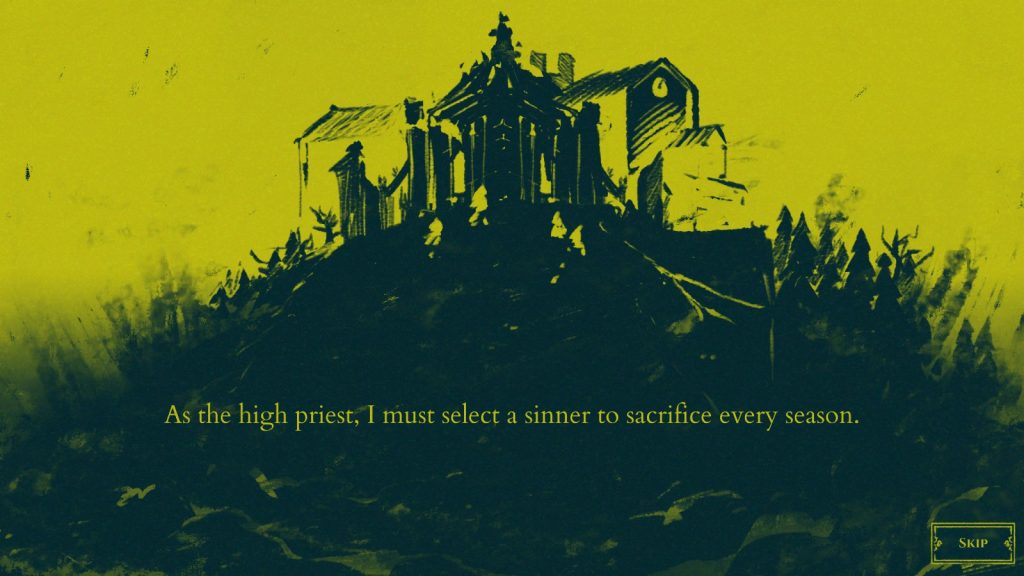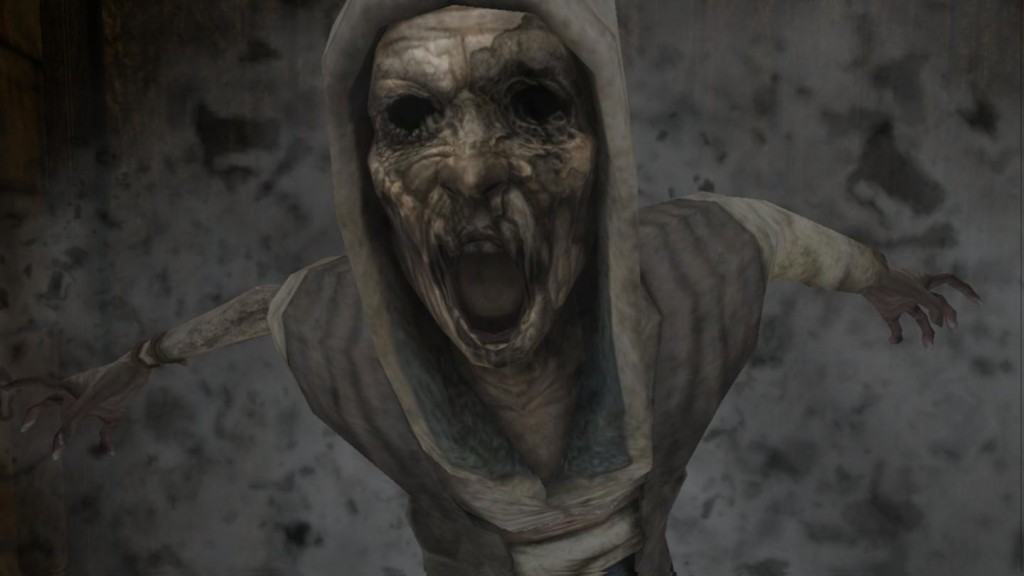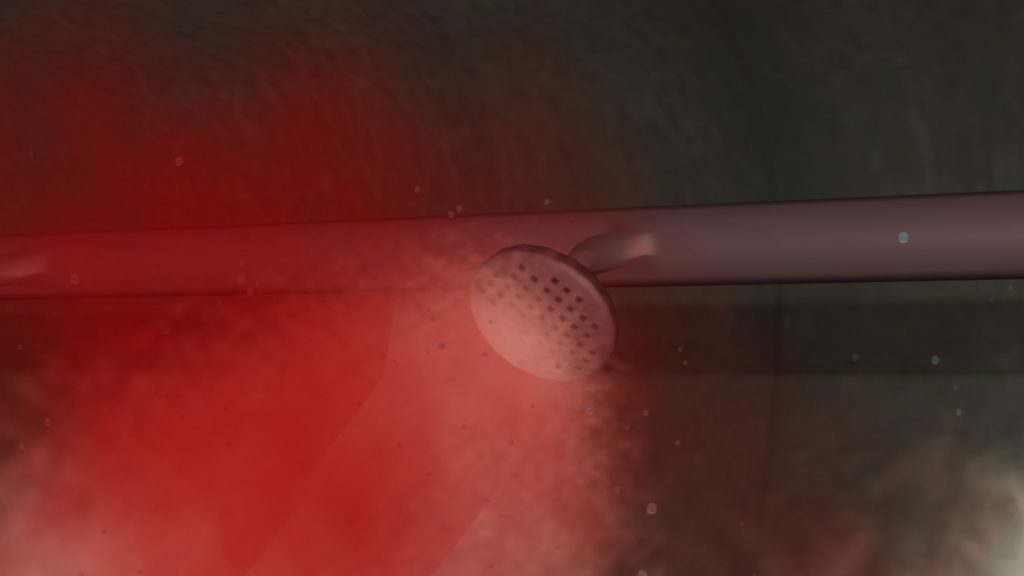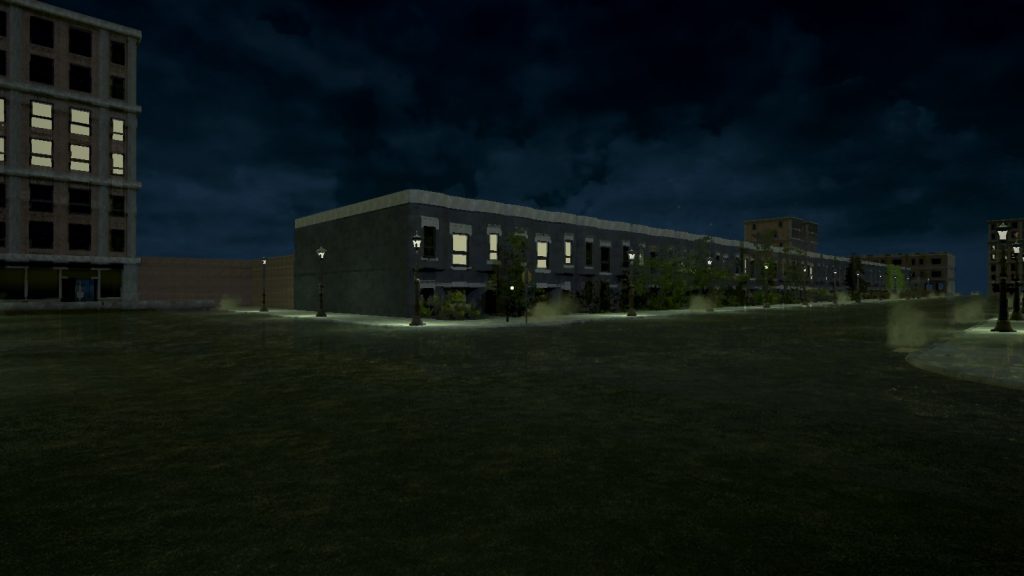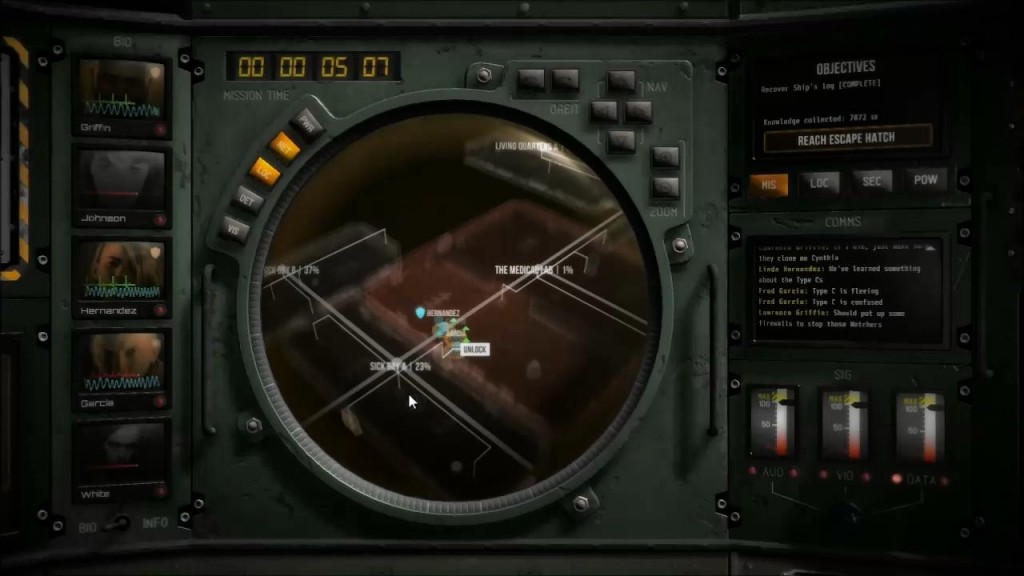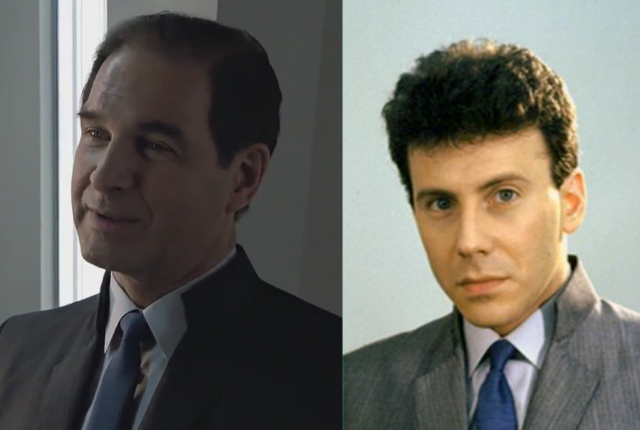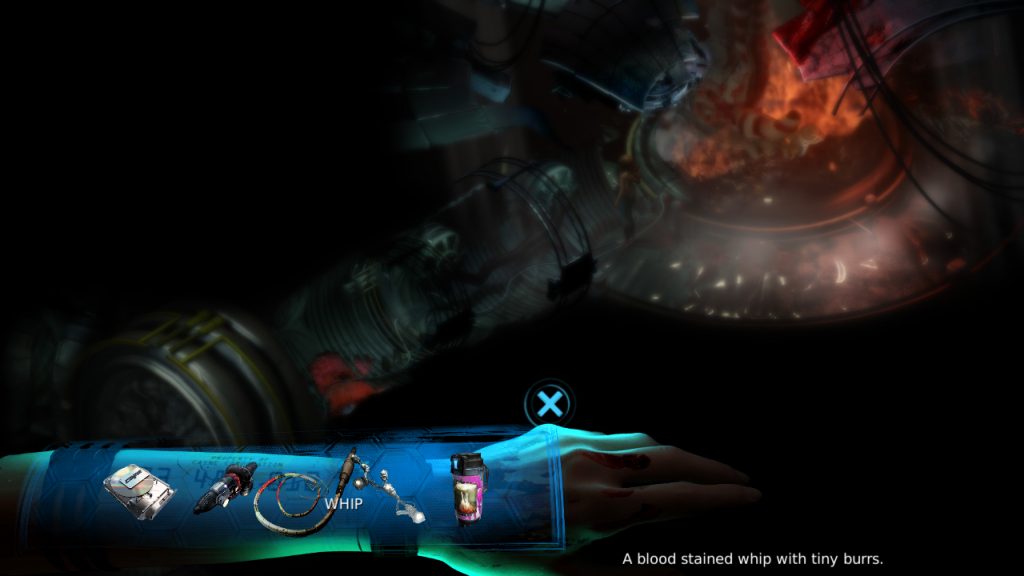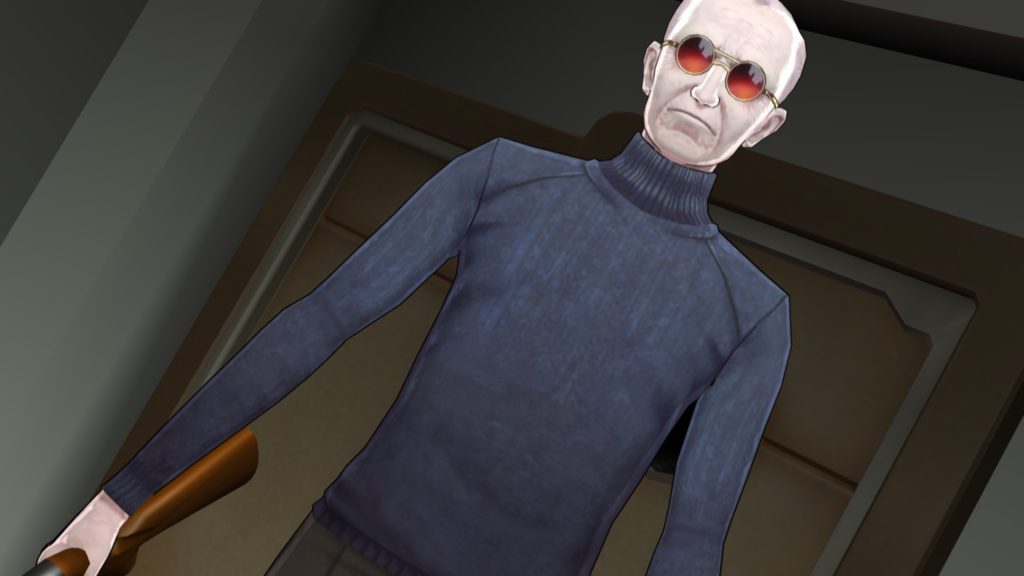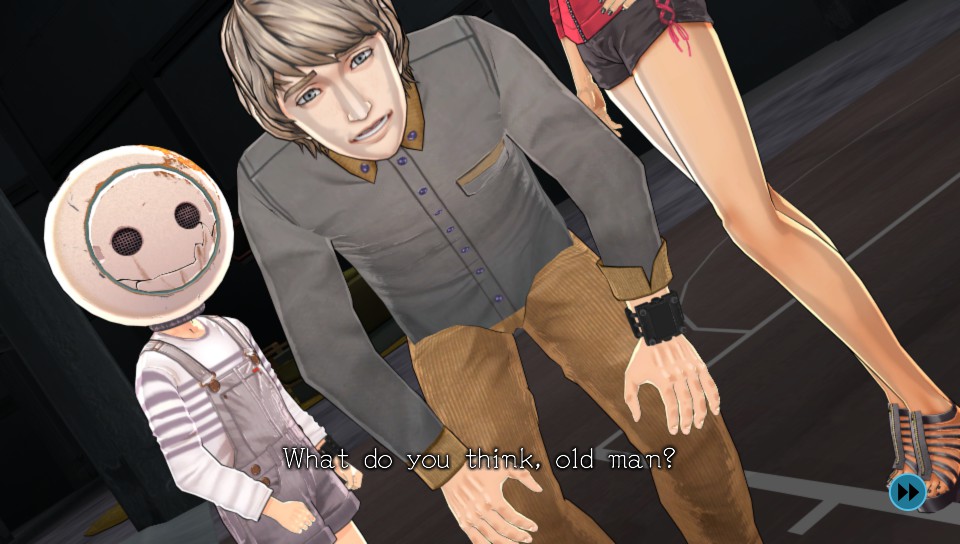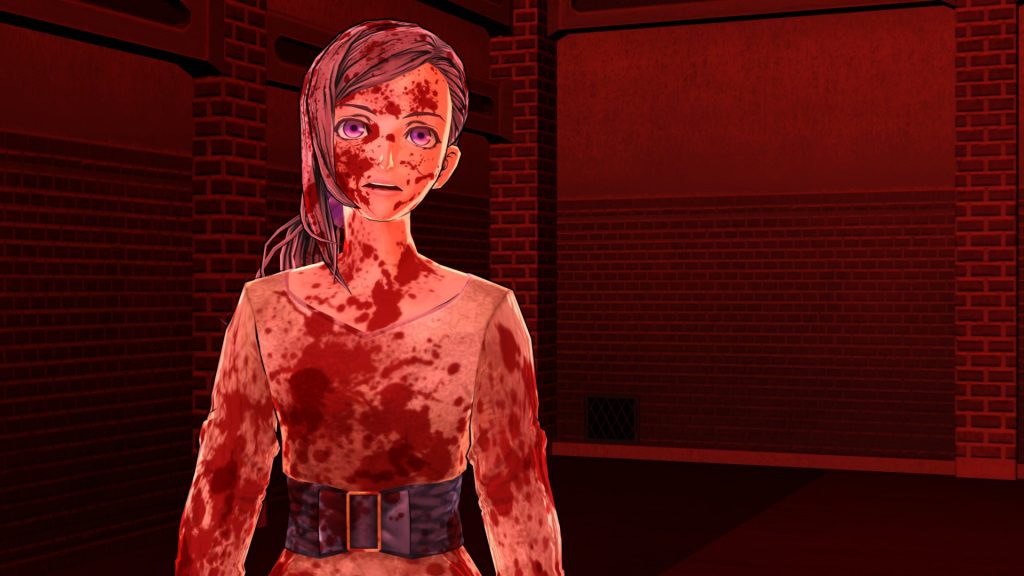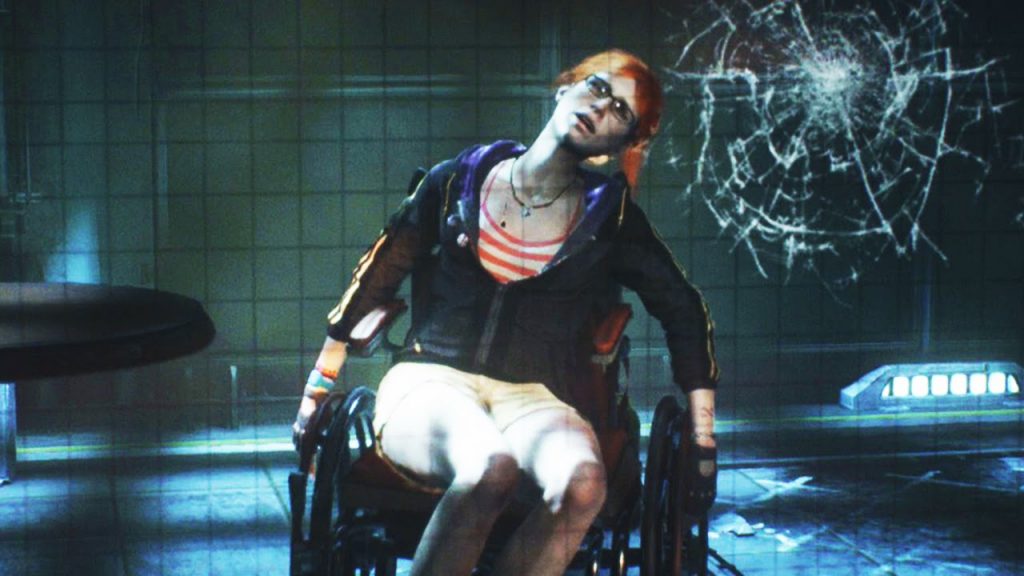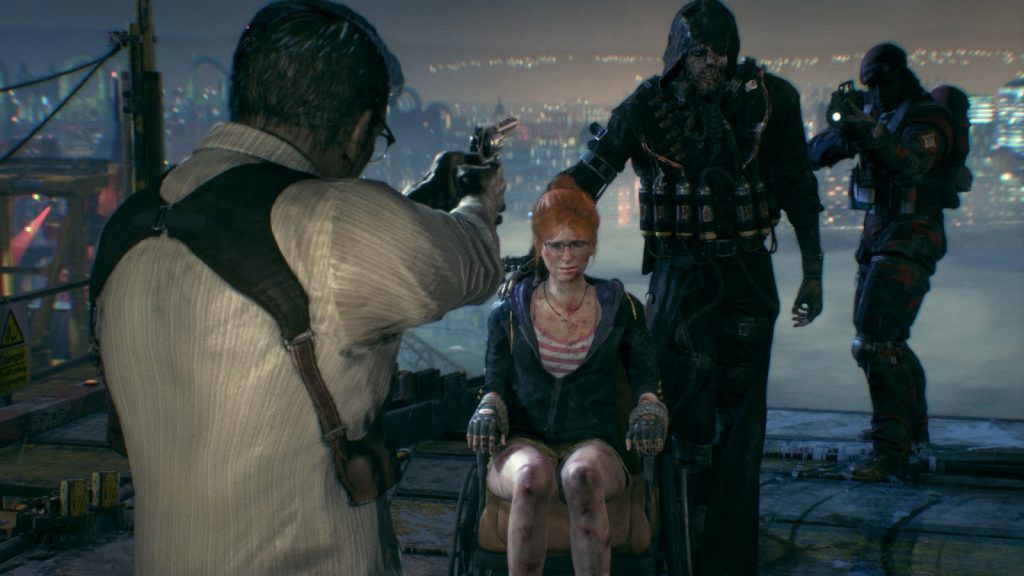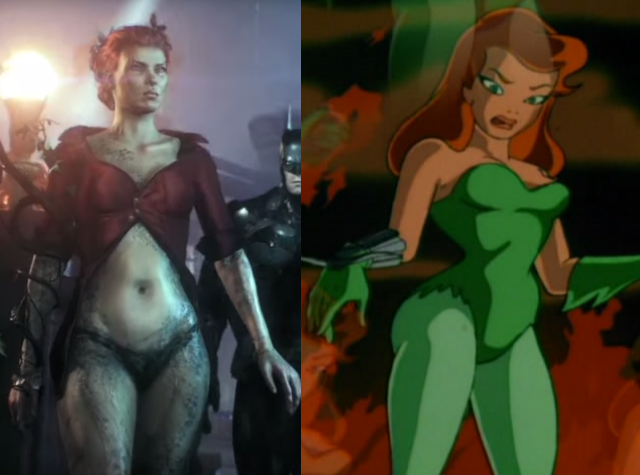Exploring Dwarf Fortress’ Legends Mode
Dwarf Fortress is a phenomenon in the world of procedural generation, creating worlds, simulating rivers, aquifers, travel, tree growth… It’s as well known for the awesome complexity of its generation and simulation as… The awesome complexity of its simulation, its bugs, some of which (like “Now that animals no longer wield weapons”, a bug we sadly never got to witness before it was fixed) are as hilarious as they can be game breaking… And its steep buy-in for new players.
But one thing isn’t really talked about all that much: Its Legends mode. Containing the history of the world you create (well, most of it. The rest is to be discovered in its other less talked about mode of Adventure Mode), it’s dry, but it contains many stories of interest, if you look hard enough.
And so, I created a world: The Eternal Realm of Omens. And I decided to explore some of its Legend Mode. Here are some notable stories.
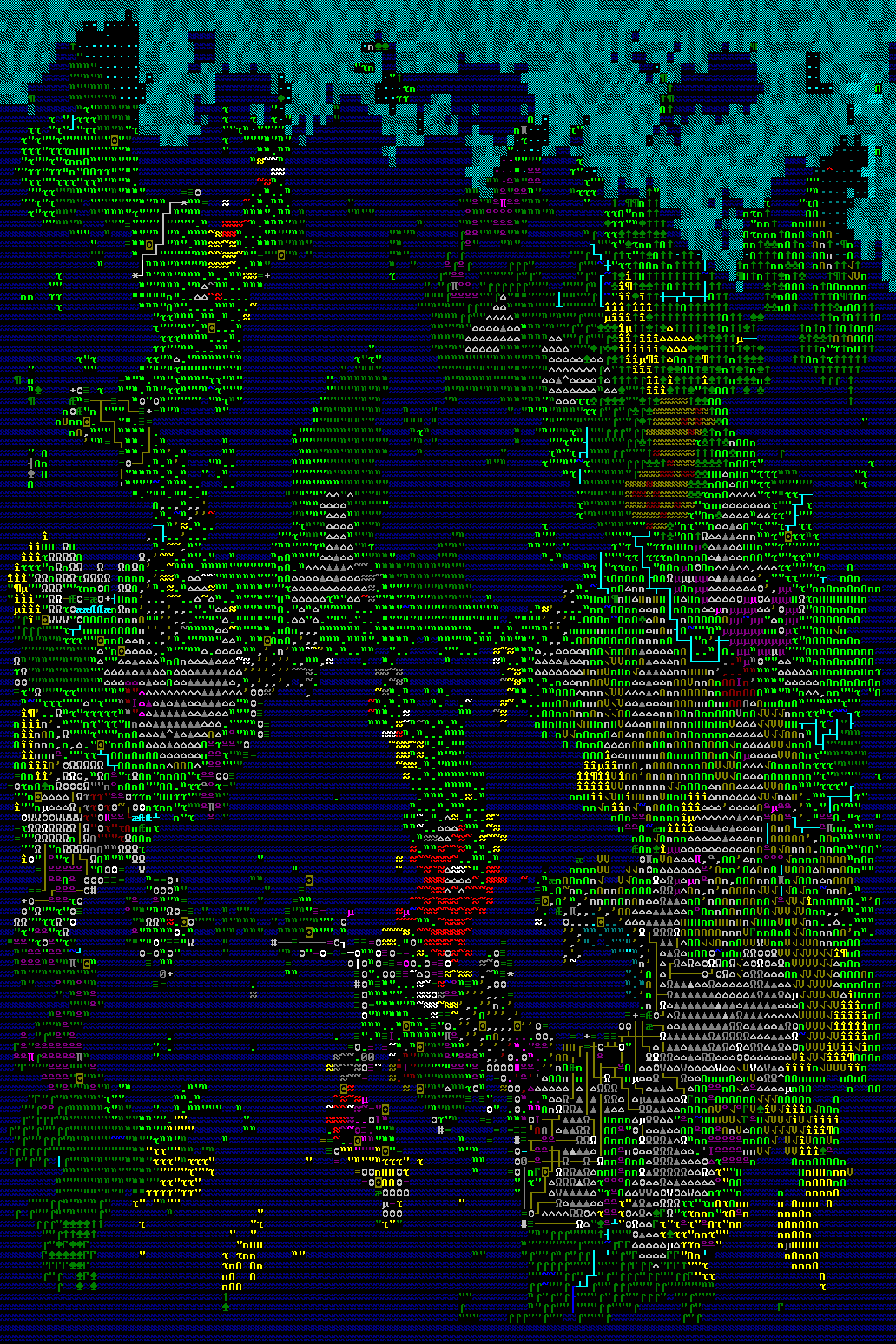
The Folly of the First Dragon
Idräth Pearlgold was the first Dragon. Indeed, he was the only Dragon. A Red Dragon, he was associated with, obviously, Wealth, and Fire. And he died in the first Winter of the world. Settling in a cave that would come to be known as Slappedsewer, the Heart of Manges, his first target, his first settlement to raze, was the Dark Tower, the fiendish demesne… Maliceblushed. Assaulting the tower, he was quickly confronted by the Gecko Fiend, Ongul Cancerburies… Who he slew, with no difficulty. Seventeen goblins and the leader of the Dark Tower were killed, before he was slain by… A goblin who had never earned a name. And never would.
Indeed, the one he slew was more notable. Pearlgold died without even a description of him surviving. While Ongul was known, a bloated, one eyed fiend, with close scales and deadly webs, the creator of Healergriffon and The Skull of Witches, an artefact that should have made him immortal, bound him to this plane. Alas, it failed, but even them, he won a wrestling competition in nearby Armordrinker, a merchant fort celebrating its first ever festival, aptly called “The Festival of Gold.” He beat three dwarves, one a necromancer: Stukos Keyheaven, the necromancer Sarvesh Regaloar, and Kûbuk Quakedoaks.
From this one folly, and Ongul’s successor, the goblin Stozu Dreadallied, we already have six leads to further stories.
Taking Up The Leads
The Skull of witches is the simplest: A garnierite tablet, it read “I am Xungôon, Pukedgutters, once of the Underworld. By Lural, I bind myself to this place.” Healergriffon was an ancient vault, and it is stored there to this day, the year 250. Lural, his creator, is a death goddess of the human civilisation calling itself “The Realms of Winding.” She created one other fiend, who began worshipping another, and is worshipped by precisely one person, a necromancer known as Tequil Faithbuttered. But she has otherwise been silent. Perhaps her summoning of Ongul was merely due to her black humour, an object lesson in her other domain: Fate. Her only artefact, a scroll of necromancy called Windmirrors, the Momentous Terrors, was bequeathed to Tequil. Another lead, and one that often bears interesting fruit.
After all, necromancers live a very long time, if they succeed.
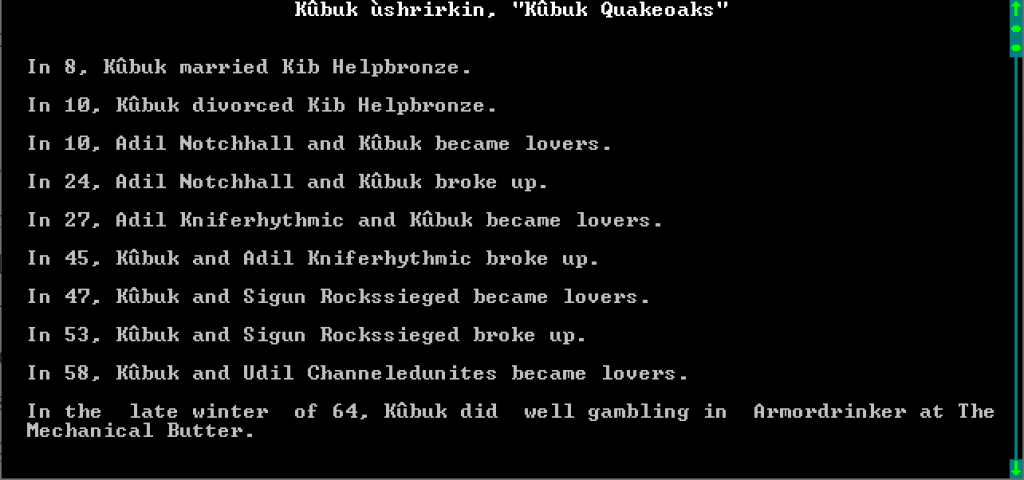
But what of the wrestlers? Well, the very first already has quite the history. Living 96 years on from his wrestling match, and dying of old age, his history is defined by two things: Serial adultery in his younger years, and wrestling. He lost precisely 2 of his many matches, although the majority, occurring in the yearly Cobalt Celebration, were with three people: Sarvesh, the necromancer, Kûbuk Quakedoaks, and Vabôk Kindledpaint. Both of the matches he lost had more participants, who weren’t these three. He was strong right up until the end, participating in many assaults on the dark places of the world, fathered four children with his first lover (the only son, Kumil Relictender, being killed by a cyclops, Nikuz Conteststrains, the Robustness of Rays), another daughter with his second lover, and one daughter and son with his eventual wife. He survived both of his sons, one of his daughters, one of his lovers, and his spouse, who he had divorced in the year 79… Returning to his first lover, Udil Channeledunites, three years later. He worshipped many deities, but only one that he truly cared about: Kåtâk Eagleleaf, the Yearling of Bears, the goddess of hunting.
He was a bookkeeper. And looking at just one of his wrestling partners, Kûbuk Quakedoaks, it seems they competed in more than just the ring… A milita commander, it seems the two competed for the affections of all three women in Stukos’ life.
So far, we have followed a chain just three links away from the first dragon, and already, we have a goddess with only one worshipper, the rivalry of a bookkeeper and a milita commander, and a tragic death. And we haven’t even gotten to the necromancers. Hell, we haven’t even seen the symbol of the dwarven civilisation to which these last two both belonged, the dwarven civilisation of… The Organised Dagger. That, we’ll get to last, for reasons that will become clear.
The Necromancers
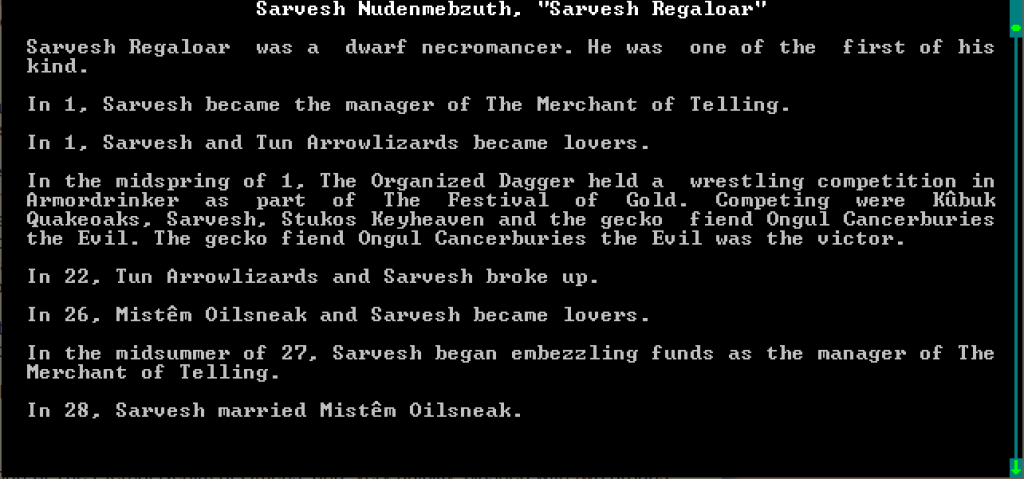
Necromancers, as you might have guessed, live a very long time, if they ever actually die. And they lead very active lives indeed. Sarvesh Regaloar is a prime example of this, having lived throughout the recorded history of The Eternal Realm of Omens.
The three dwarves of Ongul’s wrestling match were all high ranking members of their Fortress, with Sarvesh… At the top. A manager, he was already crooked, embezzling funds for 40 years of his 67 year tenure as a manager… He only got caught after 40 years. Not bad for a dwarf. Imprisoned for eight years, he very quickly realised how short his life could be, and plotted to outlast everyone, as a necromancer. Worshipping the dark goddess of death and suicide, Vesh (he was, in fact, her first worshipper), he was, a year later, gifted with a slab, that shaped itself from his stone bowl… Burieddies, carried with Sarvesh for 70 years until he eventually sealed it in his vault.
On a spousal visit, Sarvesh corrupted his wife, bribing her with promises of money and power, and she, in turn, bribed the Captain of the Guard to let Sarvesh free. He stole an artefact of legend, a scepter known as Systemscribed (and lost it three years later), attempted to intimidate Kûbuk (Good job, Sarvesh. Unsurprisingly, he screwed up), and became a prophet in Armordrinker, preaching Vesh’s words of hopelessness. Eventually, he became a monk, part of The Faith of Goals. Several times, he and his wife completely failed to bribe or intimidate members of Armordrinker, including one of his own fellow monks. Settling in Tenderlenses in 139, it took him another year to become the abbot, and has spent his entire time writing books.
The blackly funny part is that he is now the abbot of a god of courage… A necromancer in an abbey, writing self indulgent works about his explorations, himself, his previous books, and at least one on his wrestling (which he always lost.)
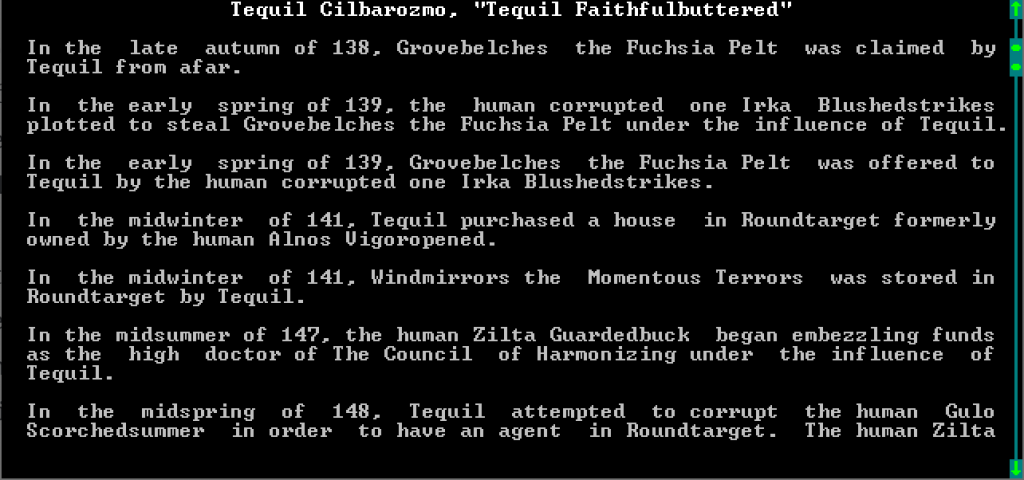
Tequil Faithfulbuttered, the only worshipper of Lural, on the otherhand, has been a master spy, funded by several people, lieutennants of several groups, and owning many judges since her 63rd year of age. At first the corrupt leader of The Chocolate Beginnings, the criminal organisation of her first home of Roundtarget, she ruled it for another 62 years after she became a necromancer. Driven from several townships due to her not aging, she has nonetheless failed in only two things: Keeping hold of Grovebelches, a holy artefact (a hood. Go figure), and attempting to assassinate, for some reason, a dwarf called Etur Channeledattacked, head executioner of Roundtarget. Always contracted by the goblin bandit leader Ûsbu Chunkdevils. Etur herself was corrupted by the goblin Damsto Wraithred in 169, the corrupt beastmaster of Roundtarget.
Let us now return to The Organised Dagger, and look at one of the more annoying aspects of exploring a world’s culture and history in Dwarf Fortress: Seeing what dwarves in the culture look like, and what their symbol looks like.
Oh, and working out who their gods are. That’s a minor pain in the ass too.
The Organised Daggers
The Organised Daggers themselves arose in the southeastern part of The Eternal Realm of Omens, and, very quickly, clashed with two groups: The kobolds of Gabatlaylmus (who were also being assaulted by The Walled Pick, another dwarven civilisation, and obliterated in 33 by a hydra), and The Dungeon of Clashing, goblins. Rapidly encompassing both, they expanded quickly, making inroads into The Walled Pick’s territory by the year 70, and just then meeting The Silken Confederation (a human civilisation) in their own, more moderate expansion. But other organisations were making inroads. By the year 250, they have expanded over most of the southeast of the continent, but share their territory with many other civilisations, including The Hideous Evil, another goblin civilisation. Considering the enmity between dwarves and goblins, they may well have stretched themselves thin.
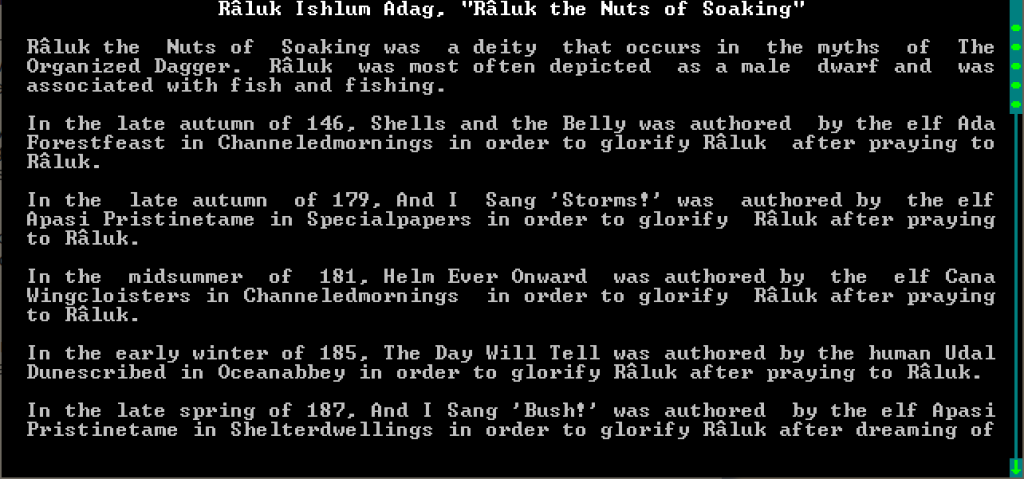
But this is easily told through the maps. What about their gods, their symbol, how the average dwarf of the Organised Daggers looks? Well… That’s harder. Because for the first, there is no link from civilisation to their deities or sub-organisations. And for the second and third, the only way is to look in adventure mode. So, obviously, I began with the deities. And this may still be an incomplete list. Six definitely female deities, five definitely male… And two insect deities. The domains of the male deities are Truth (The Angelic Honesties), Courage (Ator, the Goal of Rapidity), Rebirth, birth, and youth (Lir), Fishing (Råluk, The Nuts of Soaking), and finally, day and light (The White Twinkle. Cute.) On the female deity end, there’s… Oh boy… Thralldom (Belar), wealth, jewels, and minerals (Doren the Diamond), metals (Kadôl), salt (Migrur Bluewater), and mist, deformity, and disease (Zekrim Mazemirror.) Finally, Avum, the worker honey bee, controls the wind, the sky, the stars, the night, and the moon… And Bål, The Cloudy Dell, is the soldier ant deity of revenge, the rain, and plants.
Interesting lot! Migrur actually makes a lot of sense, so long as you remember that the most horrific areas of Dwarf Fortress’ worlds have fogs that corrupt and convert all to the undead (or worse), and that rotting bodies create the dread Miasma, clouds of disease and noxious stench. Otherwise… It would actually seem as though the culture values women as the breadwinners, the smiths, the creators, while men… Well, men can go fish, be cheery, be brave, and, generally, stay out of the way.
Alas, finding another aspect of the culture, their symbology, is, to put it bluntly, a fucking nightmare. The symbol of the civilisation and the symbol of the fort you make are two different things, and Legends Mode doesn’t, unfortunately, go into detail about the symbols of a civilisation (which, generally speaking, symbolise the culture of that civilisation), and finding out which is which means using explorer mode. In a busy dwarven citadel. Which lags the game to shit.
Nonetheless, this is a good example of the stories that happen in Dwarf Fortress’s legends mode, a mode that, on its own, can be worth exploring for the ideas about the world the game creates for you. And, apart from trying to find the civilisation’s symbol, before giving up… I enjoyed going through my own Legends to write this.


